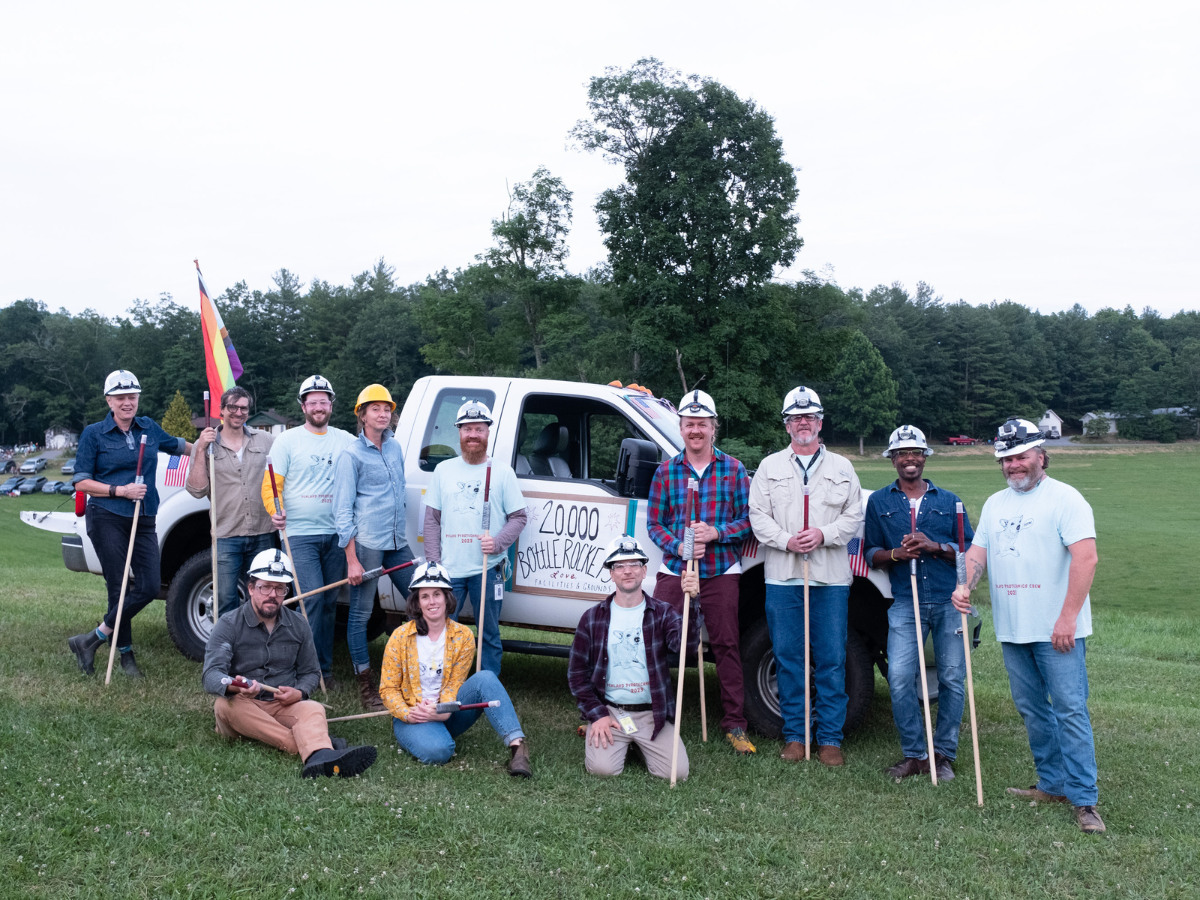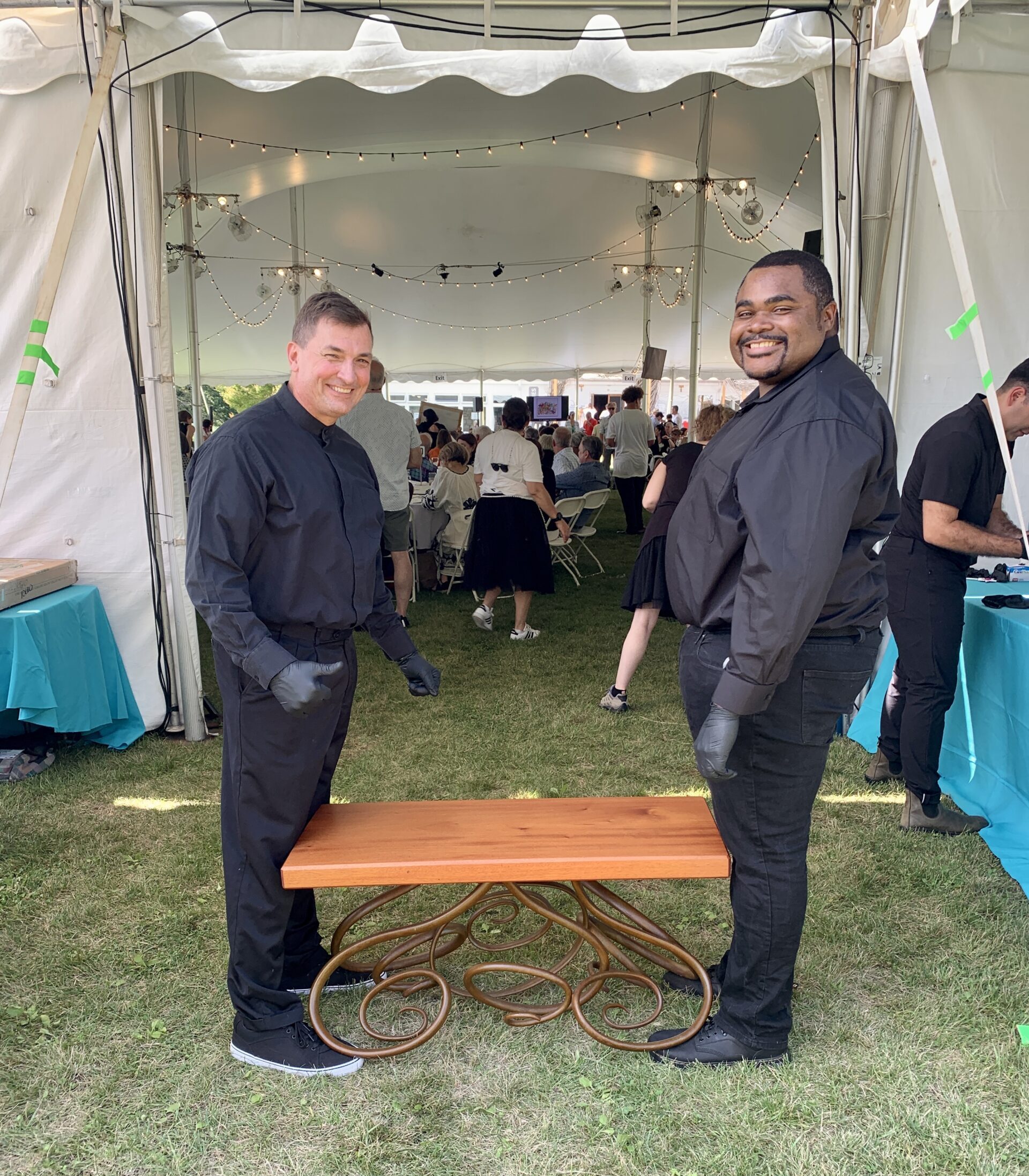 200 astonishing works found new homes and inspired bidding wars
200 astonishing works found new homes and inspired bidding wars
We wore pearls to honor Outstanding Artist Educator Elizabeth Brim, learned the surprising secret to Lucy Morgan Award recipient Julia Woodman’s success, funded climate control while fanning ourselves, and, as our Director Mia Hall so movingly put it, celebrated “our collective awe at what we humans can make with our hands.”
We spent the weekend basking in the presence of friends, new and old, breathtaking examples of contemporary craft, and our favorite views of the Blue Ridge Mountains and The Penland Knoll.
We enjoyed artist demonstrations, silent auctions, gallery talks, a Core Fellows popup, a lively cocktail party, coffee at The Barns with the Penland Resident Artists, and a much anticipated live auction under the tent.
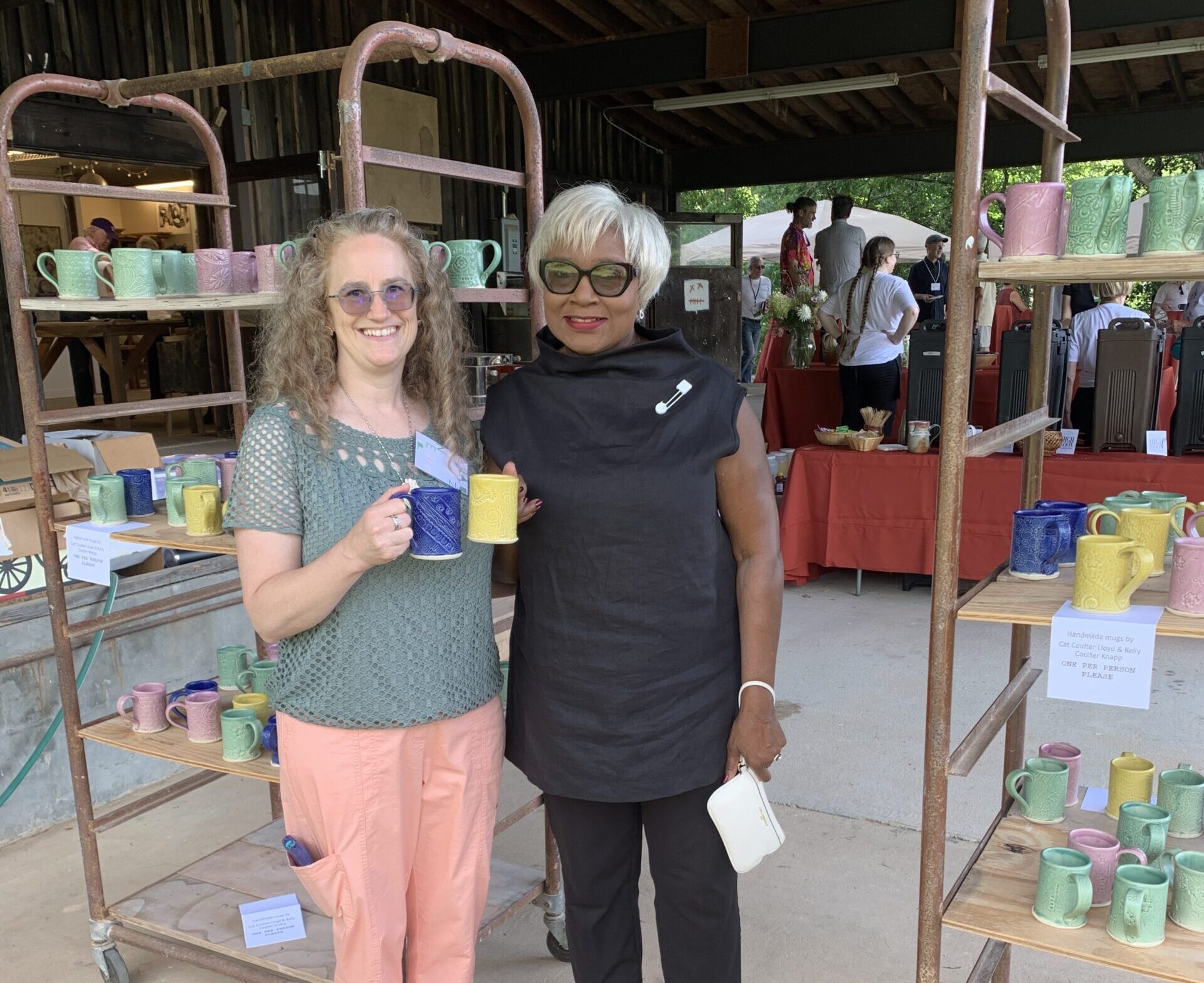 Auction guests selected unique mugs while enjoying breakfast at The Barns with the Penland Resident Artists. 2023 mug‒maker Cat Coulter Lloyd is seen here (left) with Harriet Green (right)
Auction guests selected unique mugs while enjoying breakfast at The Barns with the Penland Resident Artists. 2023 mug‒maker Cat Coulter Lloyd is seen here (left) with Harriet Green (right)
We raised $502,191!
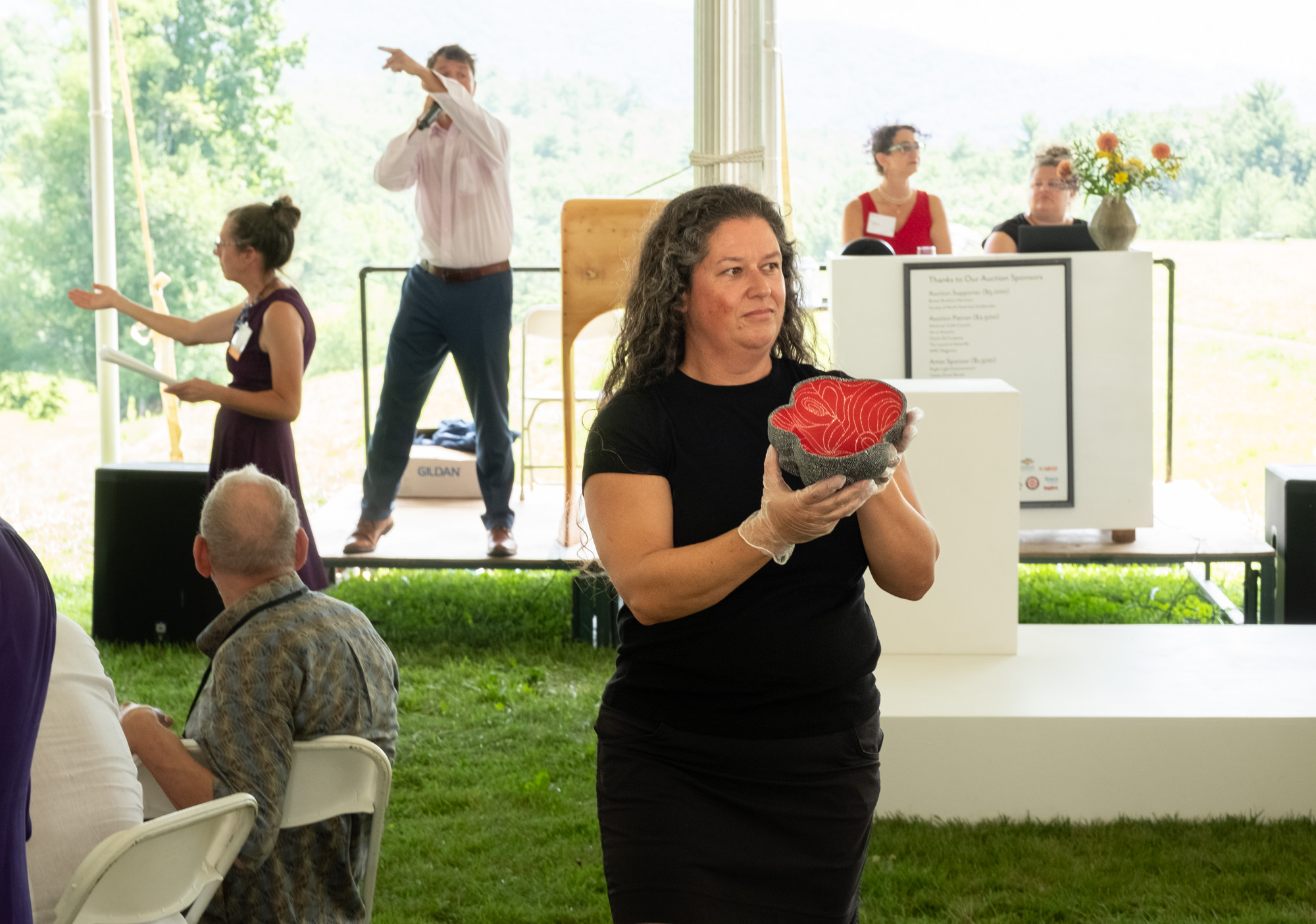 Auctioneer Jesse Miller is always a crowd favorite! Volunteer “Vanna” Jennifer Rankin shows off a special vase that was pinch-formed by the late Paulus Berensohn and decorated by Jenny Mendes.
Auctioneer Jesse Miller is always a crowd favorite! Volunteer “Vanna” Jennifer Rankin shows off a special vase that was pinch-formed by the late Paulus Berensohn and decorated by Jenny Mendes.
More than 200 inspiring works of art, donated by generous invited artists with Penland connections, found new homes as we harnessed our revelry to raise sustaining funds that will support Penland’s programs.
Together we raised $502,191 to further our mission of making lives meaningful through making. Thank you to all of the donating artists, collectors, and donors!
This year’s “Fund a Need” invited guests to directly support climate control upgrades to Penland’s campus. Attendees were sympathetic to the need in the face of unseasonably warm temperatures. We are excited to report that we surpassed our goal of $100,000, raising $108,700 for HVAc upgrades that will help preserve aging buildings and provide greater comfort for our students and instructors.
 Fans were a theme of the weekend as we raised $108,700 for HVAC upgrades that will help preserve aging buildings and provide greater comfort for our students and instructors. Auction captain Corey Pemberton helped us get excited about climate control!
Fans were a theme of the weekend as we raised $108,700 for HVAC upgrades that will help preserve aging buildings and provide greater comfort for our students and instructors. Auction captain Corey Pemberton helped us get excited about climate control!
Special Honors
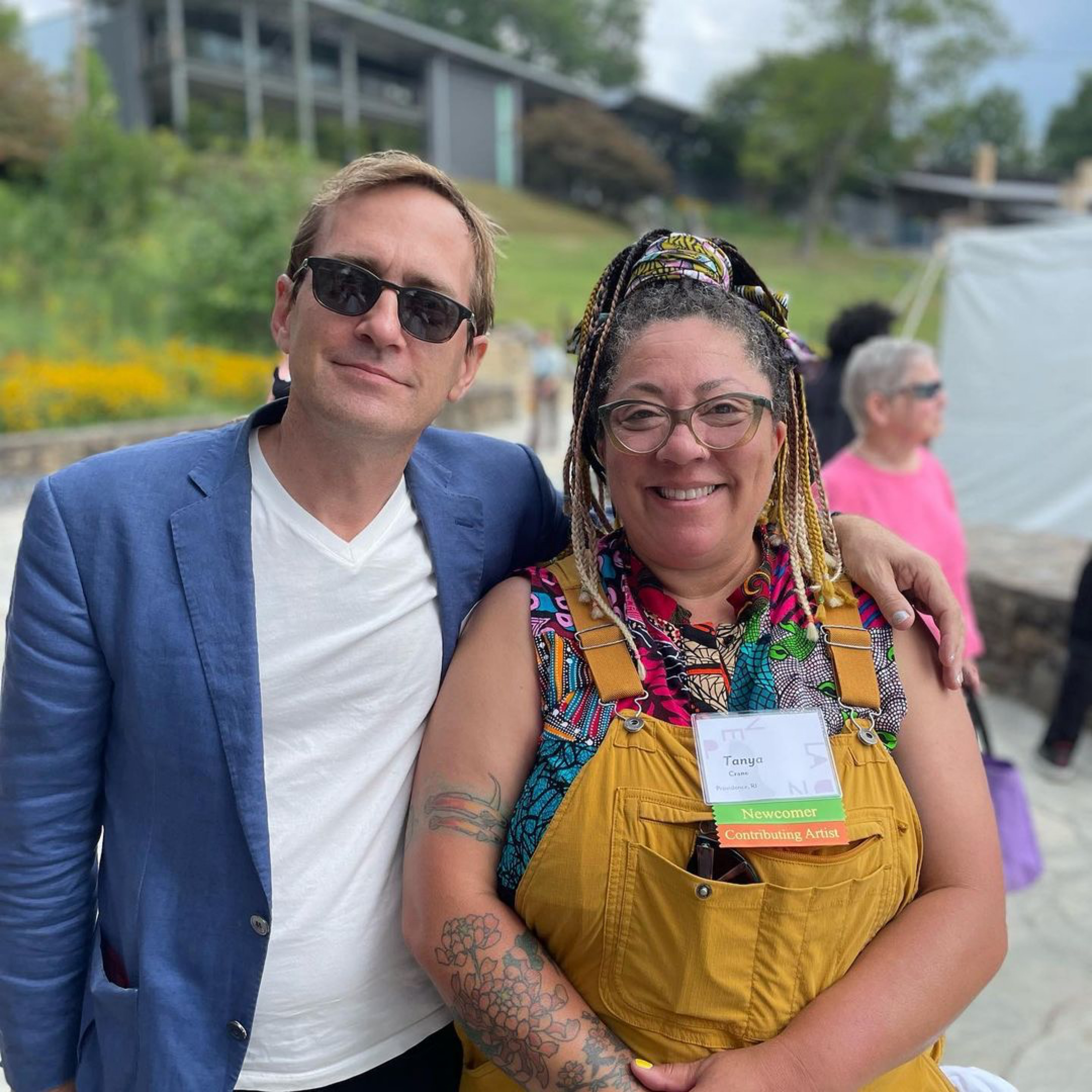 Featured artists Tanya Crane (right) and Dan Estabrook (left)
Featured artists Tanya Crane (right) and Dan Estabrook (left)
At the 38th Annual Penland Benefit Auction, it was our great honor to celebrate the contributions of featured artists Tanya Crane and Dan Estabrook. To mark the occasion, thoughtful short films about Tanya and Dan were commissioned and screened at the event (Click their names to view).
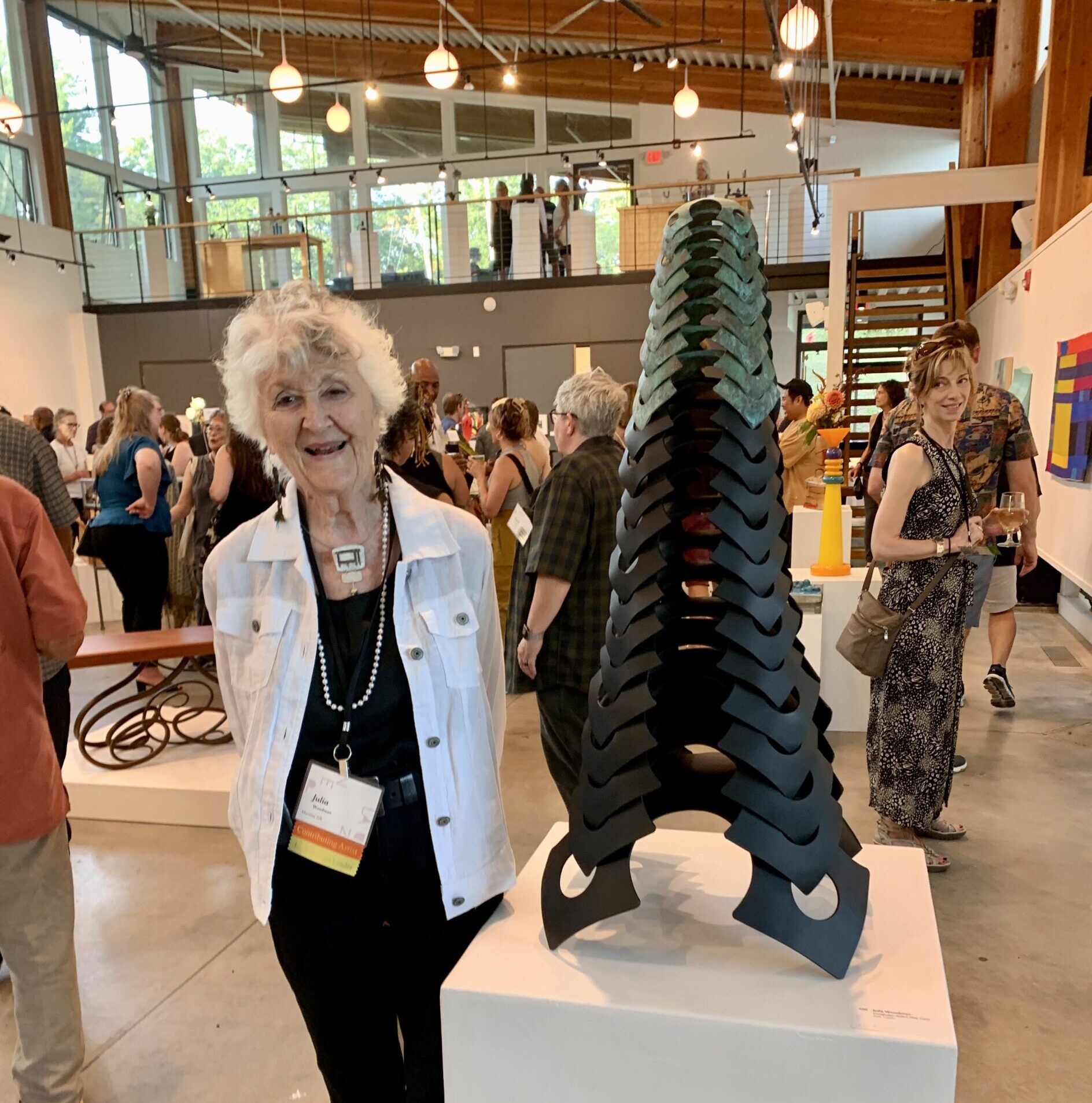 Julia Woodman, pictured here with her piece “Computer Aided Pine Cone” was the first recipient of the Lucy Morgan Award.
Julia Woodman, pictured here with her piece “Computer Aided Pine Cone” was the first recipient of the Lucy Morgan Award.
Receiving the first ever Lucy Morgan Award in honor of her special relationship with Penland, Julia Woodman was presented with a lovely necklace, crafted for the occasion by longtime friend Merrick Earle who took a Penland workshop with Julia. Upon receiving her award, Julia, who has taken 26 Penland workshops, remarked, “I can’t believe I’m being honored for having fun.” Julia spoke movingly of her trepidation about going back to school after raising her family and shared an intimate detail about her life: for the past forty years, a group of monks has been praying for her five times a day. Read more about Julia’s extraordinary journey HERE.
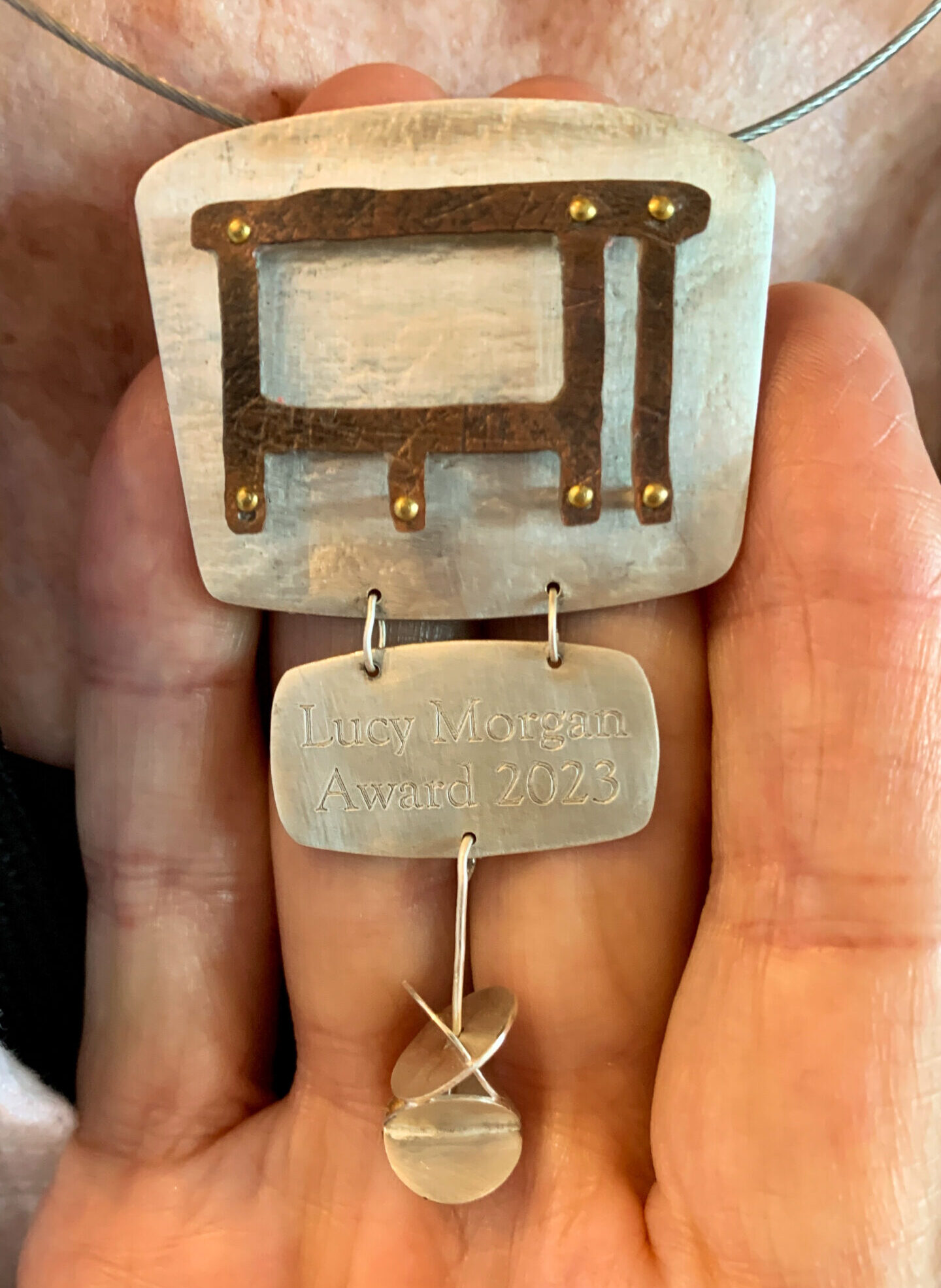 Lucy Morgan Award necklace by Merrick Earle
Lucy Morgan Award necklace by Merrick Earle
Honored as this year’s Outstanding Artist Educator, Elizabeth Brim spent the weekend surrounded by some of the many blacksmiths that she has inspired, mentored, and learned from over the years. Many took the opportunity to wear pearls in honor of Elizabeth’s habit of always wearing pearls at the forge. At the main event, tables under the tent were adorned with custom centerpieces, created by 20 of Elizabeth’s friends. At a special price of $395, these “cynosures” helped kick off the live auction with a race to claim them, raising over $15,000 for Penland.
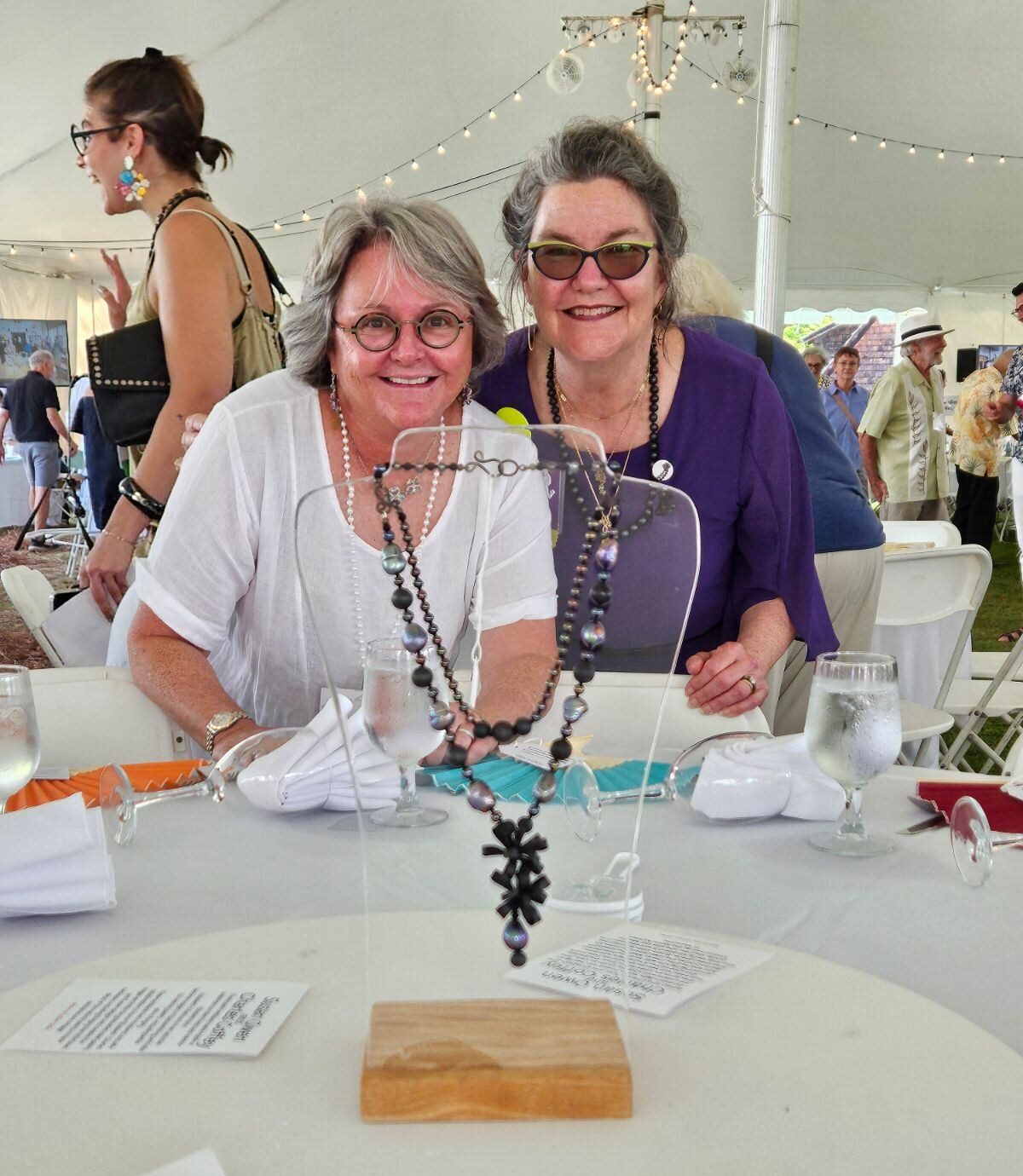 Guests rushed to acquire the steel centerpieces, created in honor of Outstanding Artist Educator Elizabeth Brim. These steel pearls were created by Susan Owen (right) and Charles Coffey. Beth Kokol (left) was excited to acquire this special piece!
Guests rushed to acquire the steel centerpieces, created in honor of Outstanding Artist Educator Elizabeth Brim. These steel pearls were created by Susan Owen (right) and Charles Coffey. Beth Kokol (left) was excited to acquire this special piece!
Contributing cynosure artists:
Vivian Beer, Autumn Brown, James D. W. Cooper, Maegan E. Crowley, Andy Dohner, Seth Gould, Warren Holzman, Marvin Jensen, Rachel Kedinger, Dave MacDonald, Marc Maiorana, Zack Noble, Susan Owen and Charles Coffee, Suzanne Pugh, John J Rais, Mike Rossi, James Viste, Haley Woodward, and Stephen Yusko.
A special event honoring Elizabeth was held at the Northlight mezzanine as friends and peers gathered around to share stories and let Elizabeth know what she has meant to the Penland, craft, and blacksmithing communities. Under the main tent, just before the live auction, Elizabeth addressed the crowd. Overcome with emotion, she spoke about her journey to independence through blacksmithing and how her father “relaxed a little” when she bought herself a used pickup truck “with money I made from selling my first pair of high heeled shoes and an apron sculpture.” Addressing the crowd of friends, Elizabeth said,
I’ve always said I needed to be very good to deserve all of the opportunities I have been given. To stand here receiving this award as somebody who encouraged, influenced and taught people to be the best they can be is an immense honor and validation. I am extremely grateful to the Penland School of Craft and to all of you for supporting this wonderful place.
We are grateful to have friends like Tanya, Dan, Julia, and Elizabeth working to make Penland a special place for us all.
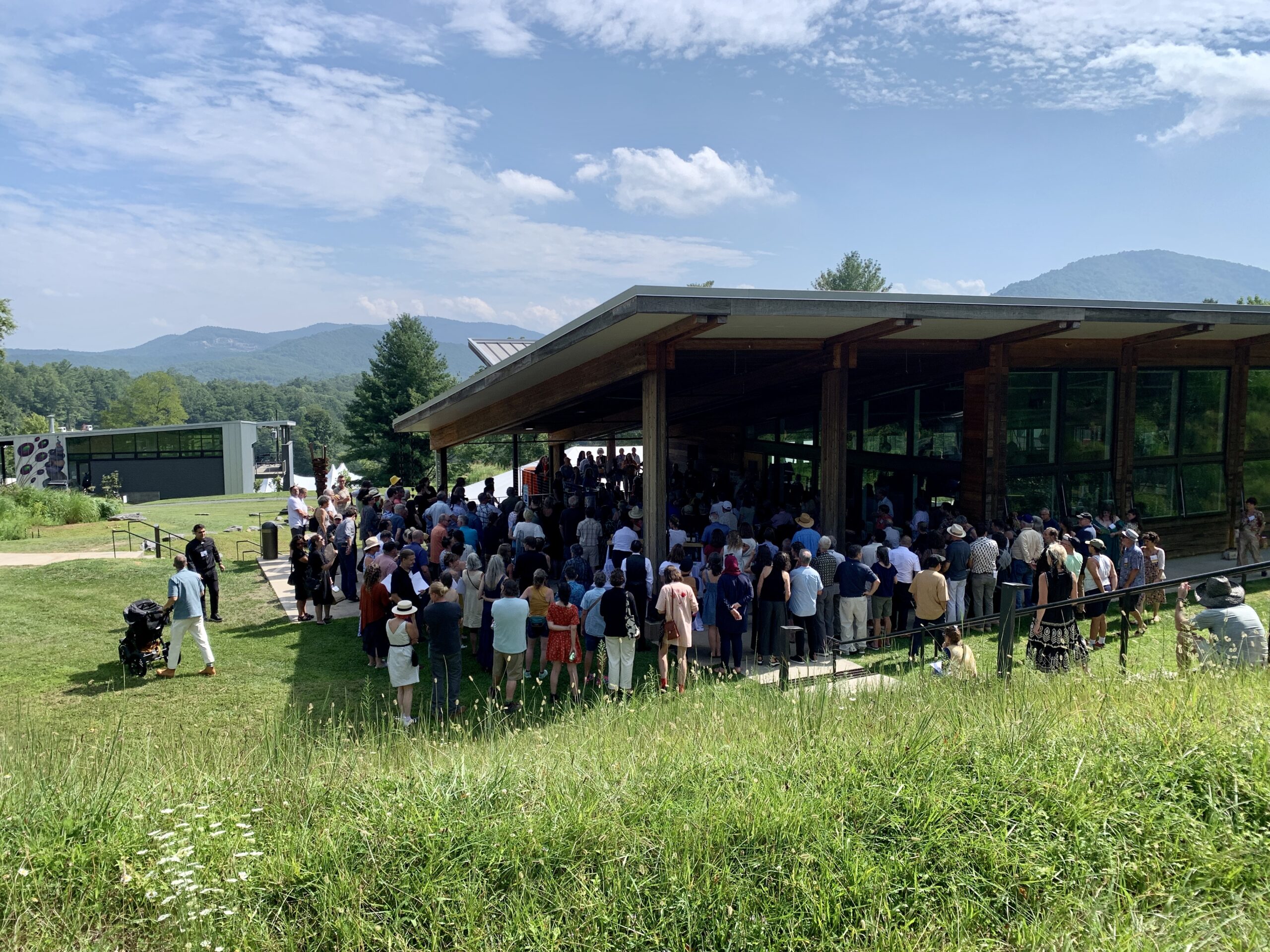 Standing room only for Elizabeth Brim!
Standing room only for Elizabeth Brim!
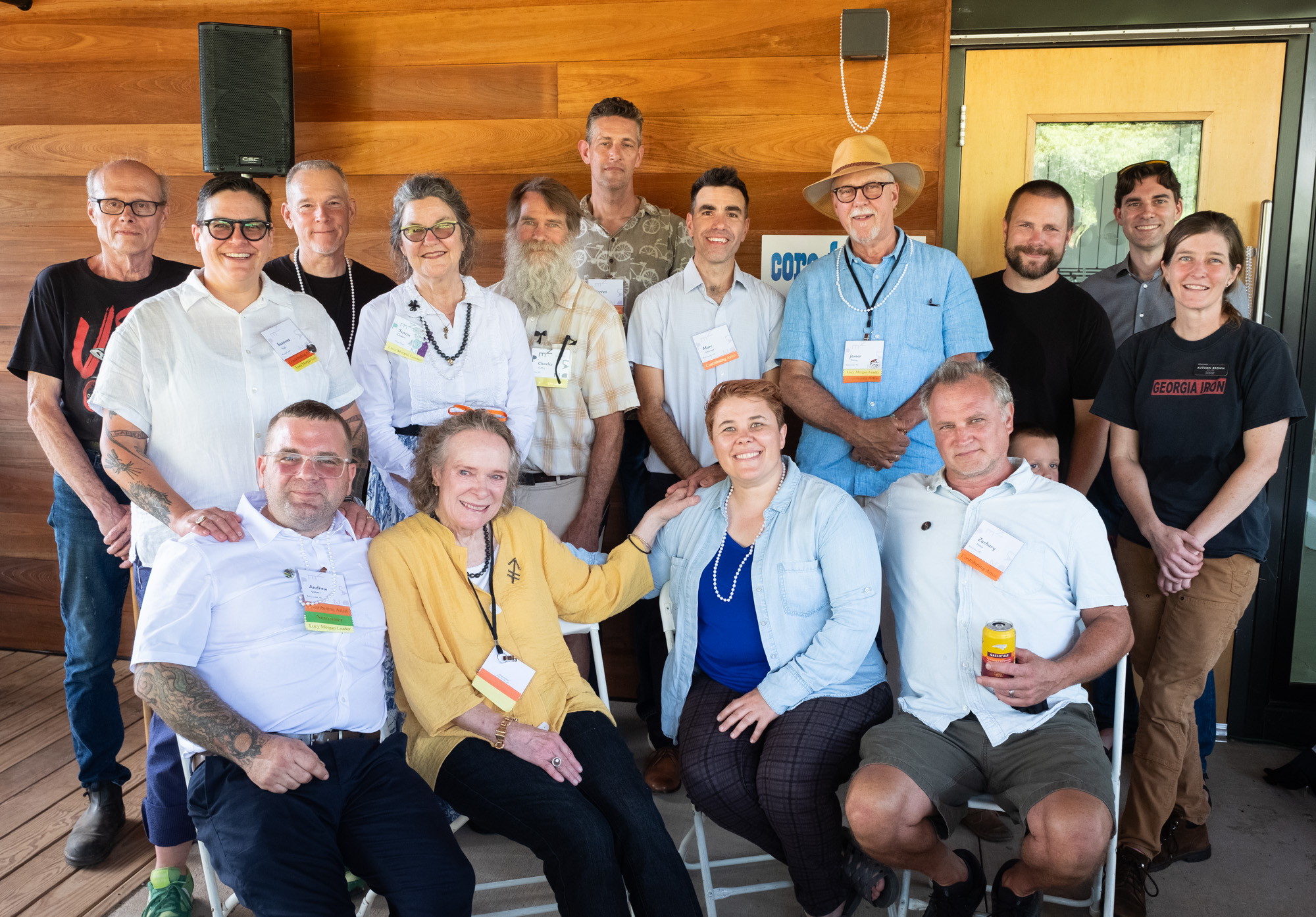 Elizabeth Brim together with many of the artists who contributed custom steel centerpieces in her honor.
Elizabeth Brim together with many of the artists who contributed custom steel centerpieces in her honor.
Thank You!
Our hearts are full! Thank you to everyone who made the 38th Annual Penland Benefit Auction a great success. Thank you to our patrons, contributing artists, sponsors, volunteers, summer interns and staff. Our annual auction is a labor of love, from the creation of unique artwork to that special weekend when we gather to celebrate craft, Penland, and each other. Thank you!
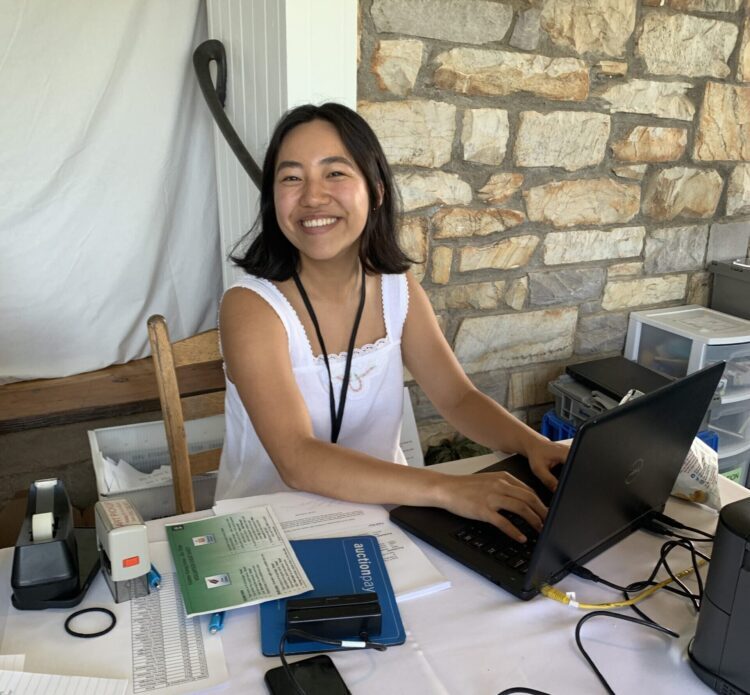 Summer intern Mindy helped make the 38th Annual Benefit Auction a great success. Thank you to development interns Mindy Yi, Ethan Helow, and Astrid Guerrero!
Summer intern Mindy helped make the 38th Annual Benefit Auction a great success. Thank you to development interns Mindy Yi, Ethan Helow, and Astrid Guerrero!
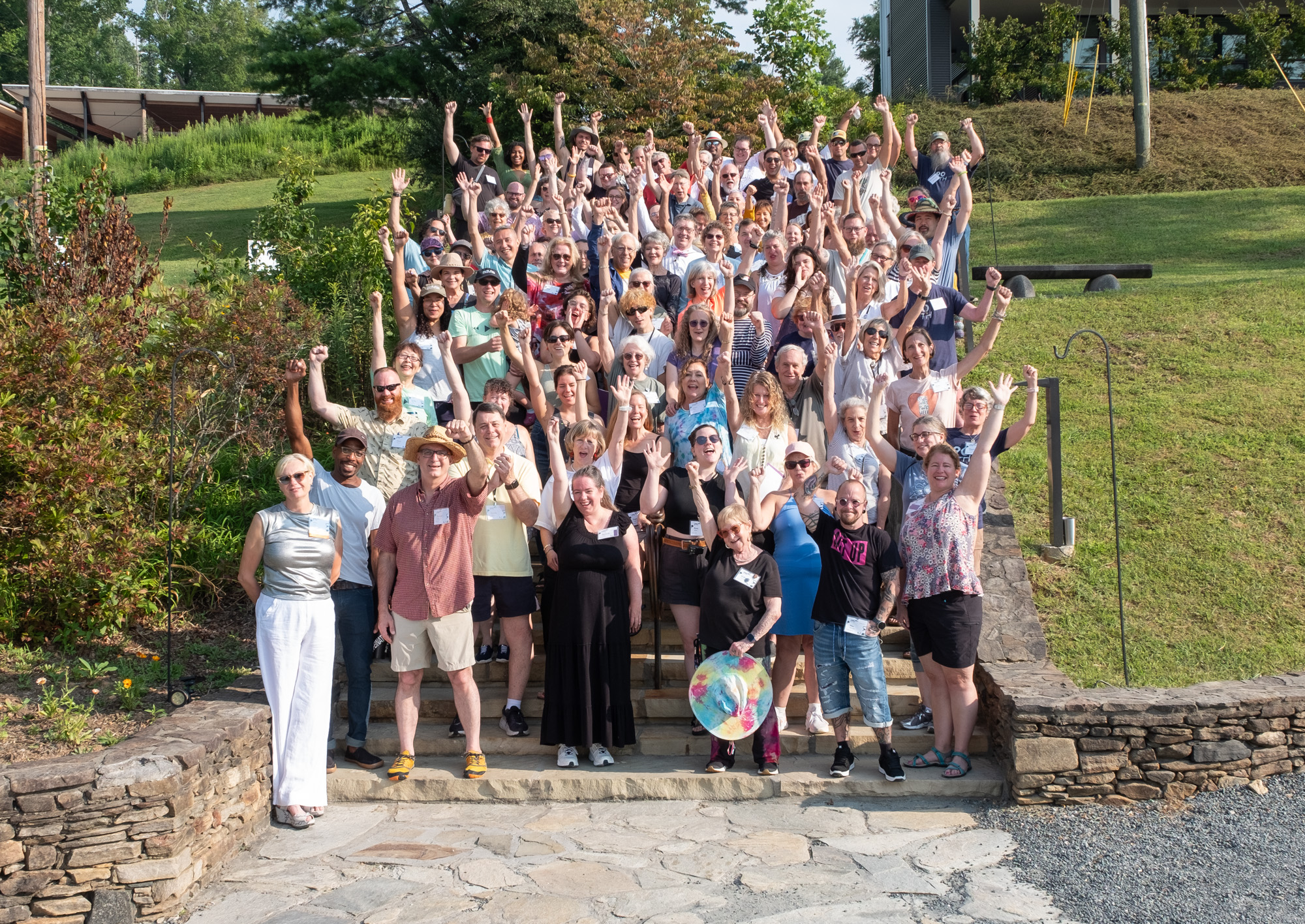 Wonderful volunteers make the Penland Benefit Auction possible (and fun)!
Wonderful volunteers make the Penland Benefit Auction possible (and fun)!
2023 Contributing Artists
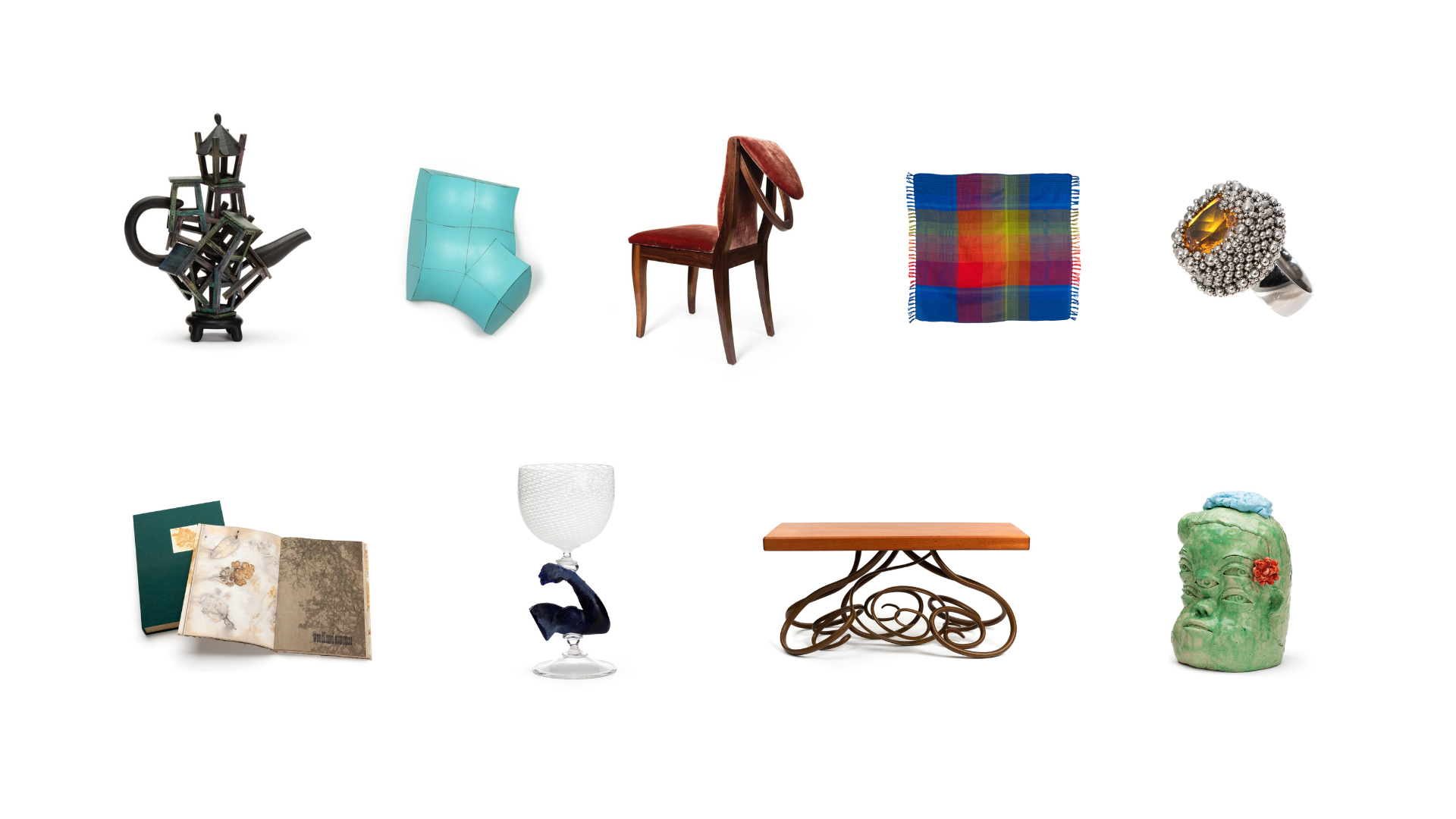
View the 38th Annual Penland Benefit Auction Catalog HERE.
Contributing artists: Cathy Adelman, Stanley Mace Andersen, Eleanor Anderson, Kurt Anderson, Sarina Angell, Eleanor Annand, Adam Atkinson, Dan Bailey, Phillip Baldwin, Boris Bally, Kenneth Baskin, Cat Bates, Rick Beck, Vivian Beer, Paulus Berensohn, 1933-2017, Alex Bernstein, Lisa Blackburn, Cynthia Bringle, Edwina Bringle, Autumn Brown, Ashley Buchanan, Jennifer Bueno, Thor and Jennifer Bueno, Jay Burnham-Kidwell, Stormie Burns, Critz Campbell, Ken Carder, Jason Chakravarty, Pattie Chalmers, Rebecca Chamlee, Daniel G. Clayman, David Harper Clemons, Martha Clippinger, Ann Coddington, Margaret Couch Cogswell, Kat Cole, Andrèa Keys Connell, James D. W. Cooper, Béatrice Coron, Nate Cotterman, Tanya Crane, Maegan E. Crowley, Marianne Dages, Naomi Dalglish and Michael Hunt; Bandana Pottery, Jennifer Ling Datchuk, Paige Hamilton Davis, Nick DeFord, Dail Dixon, Andy Dohner, Sondra Dorn, Ben Dory, Caroline Douglas, Beth Dow, Lynn Duryea, David Eichelberger, Rostislav Eismont, Catharine Ellis, Sanam Emami, Melissa Engler, Daniel Essig, Vicki Essig, Dan Estabrook, Annie Evelyn, Lauren Faulkenberry, Susan Feagin, Shane Fero, Alida Fish, Susie Ganch, Rachel K. Garceau, Daniel Garver, Greg Gehner, Terry Gess, Joanna Gollberg, Seth Gould, Carmen Grier, Bill Griffith, Hoss Haley, Mia Hall, Frank Hamrick, Douglas Harling, Abie Harris, Julia Harrison, LUKE Haynes, James Henkel, Adriane Herman, Mark Hewitt, Leigh Anne Hilbert, Overlap Sewing Studio, Morgan Hill, Everett Hoffman, Warren Holzman, Tom Huang, Mi-Sook Hur, Maggie Jaszczak, Tom Jaszczak, Mercedes Jelinek, Marvin Jensen, Nicholas Joerling, Anna Johnson, David Jones, Frederick Gladding Kahl, Erin Keane, Rachel Kedinger, Alicia D Keshishian, Kathy King, Jeana Eve Klein, Julie Leonard, Maia Leppo, Suze Lindsay, Janet Link, Tara Locklear, Dave MacDonald, Warren Mackenzie, 1924-2019, Edna Madera, Marc Maiorana, James Malenda, Jeannine Marchand, Richard Margolis, Lauren Markley, Courtney Martin, Lydia Martin, E. Vincent Martinez, Sharon Massey, Tim McCreight, Barbara McFadyen, Laura Jean McLaughlin, Jenny Mendes, Forrest Middelton, Cedric Mitchell, Jim Moran, Morgan, Zack Noble, Maria Fernanda Nuñez Alzate, Libby O’Bryan and Giovanni Daina Palermo (Rite of Passage), Sean O’Connell, Marsha Owen, Susan Owen and Charles Coffey, Winnie Owens-Hart, Kristina Paabus, Keun Ho Peter Park, Kit Paulson, Lisa Pedolsky, Anne Petters, Kenny Pieper, Andrew Polk, Kathryn Polk, Dan Price, Graeme Priddle, IlaSahai Prouty, Suzanne Pugh, Amy Putansu, John J Rais, Billy Renkl, Ché Rhodes, Ellie Richards, Sang Parkinson Roberson, Linda Foard Roberts, Holly Roberts, Emily Rogstad, Sylvie Rosenthal, Mike Rossi, Andy Rubin, Kari Russell-Pool, Alyssa Salomon, Blue Skies Workroom, Yolanda Sánchez, Wyatt Severs, Hitomi Shibata, Takuro Shibata, Lars Shimabukuro, Gertrude Graham Smith, Tremain Smith, Kevin Snipes, Liz Sparks, Leigh Suggs, Lynn Sures, Tim Tate, Amy Tavern, Janet Taylor, Shoko Teruyama, Demitra Thomloudis, Bob Trotman, Marlene True, Julia Turner, Sarah E Vaughn, James Viste, Eileen Wallace, Paul Andrew Wandless, Tali Weinberg, Sarita Westrup, Adam Whitney, Hayden Wilson, Laura Wood, Julia Woodman, Haley Woodward, Danni Xu, Hiroko Yamada, Kensuke Yamada, Stephen Yusko, Mary Zicafoose.
Thank you!


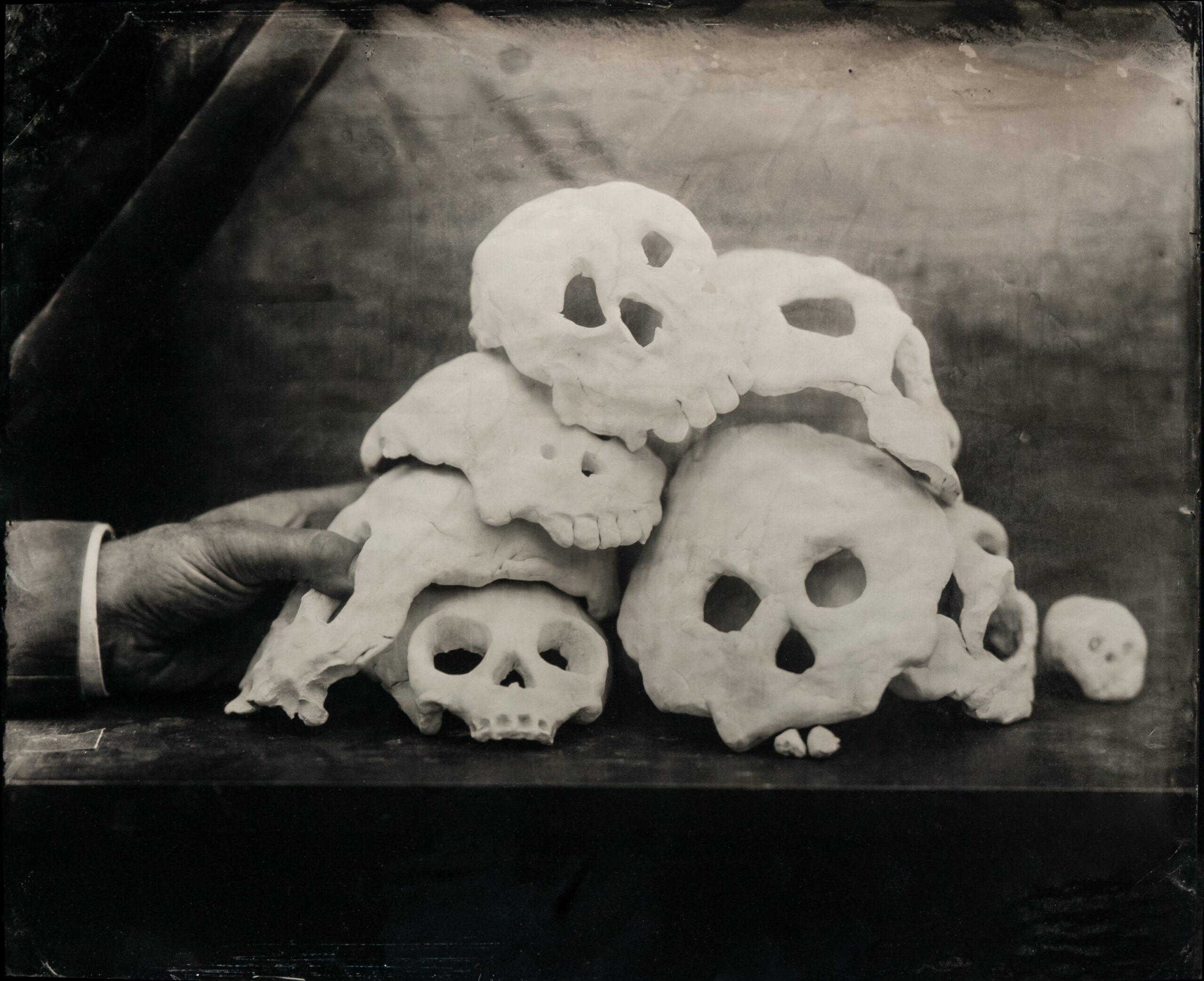 Dan Estabrook
Dan Estabrook